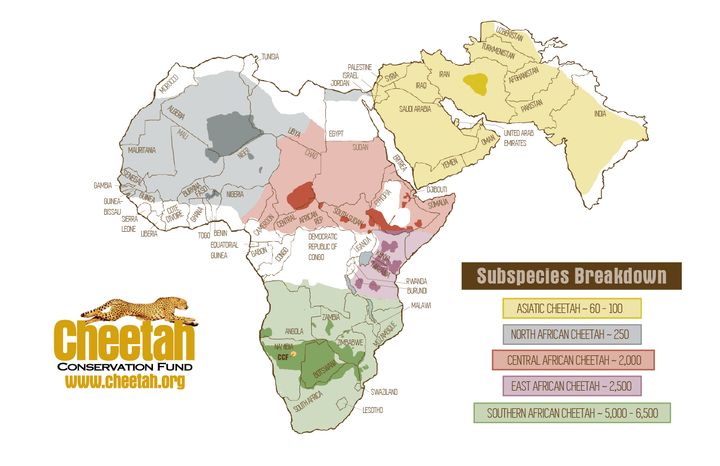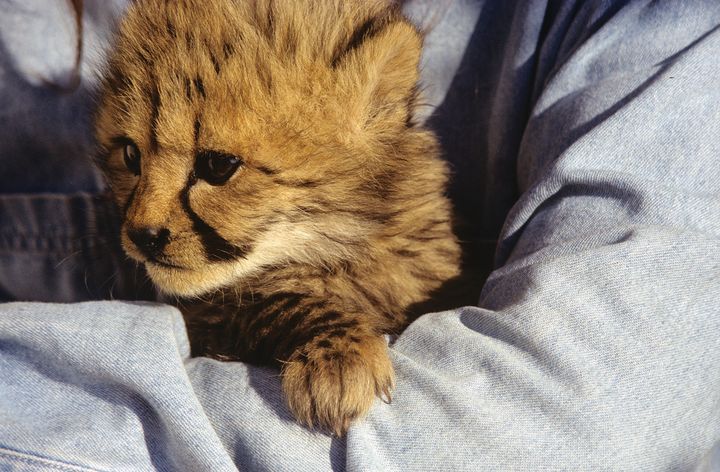Adopt A Cat Month is a yearly observation, during the month of June, started by domestic animal shelters. Coinciding with “kitten season”, from early spring through the summer, this is the time when shelters busy themselves looking for homes for millions of domestic cats. During June, Cheetah Conservation Fund (CCF) celebrated Adopt A Cat Month by asking for support to keep cheetahs in their wild homes.
Cheetahs are the smallest of the big cats and are a unique and very old species. Around 10 to 12,000 years ago, a climate shift at the end of the last ice age caused a mass extinction of many species and few cheetahs survived leaving them with a very limited gene pool. Today, habitat loss, human/wildlife conflict, and the illegal pet trade have contributed to a further shrinking of the population, with the current cheetahs’ range reduced across eastern and southern Africa with a very small population in Iran. While the domestic cat became more popular and widespread over the past 10,000 years becoming a favored pet around the world, the cheetah has become a threatened species on the brink of extinction.

Lighter colors denotes historic range & darker colors denote current range
Cheetahs Don’t Have an Overbreeding Problem.
Adopt A Cat Month messaging usually focuses on the overpopulation of cats, cheetahs don’t share this problem. There are currently less than 8,000 cheetahs remaining in the wild and they are considered extinct in more than 20 of their former range countries. The biggest threats to survival are human/wildlife conflict and loss of habitat. Captive cheetah breeding is not as successful as many large carnivores, leaving the wild population more important for species survival.
Cats of all species from cheetahs to gray tabbies, have a wide range of breeding behaviors. Domestic cats experience estrus on a regular cycle corresponding to day lengthening and warmer weather. In tropical areas where day length doesn’t change very much, female domestic cats will breed year-round. Cheetahs in captivity on the other hand have very unpredictable breeding cycles that correspond to environmental stimulus on an individual basis. Knowing when a female cheetah is ready to mate involves lots of behavioral observation, fecal testing, and patience.
The Cheetahs in Your Neighborhood
Domestic cats have a reputation for killing birds and small mammals when they live partially or fully outside. As a result the reaction to outdoor cats can be very negative; they can be thought of as pests and as a result are poisoned or trapped. Like feral domestic cats, cheetahs and other predators have also been viewed as vermin; they were thought to threaten livestock and livelihoods.
When I started CCF in 1990, Namibian farmers were killing cheetahs by the hundreds per year. People did not know how to live alongside predators and they didn’t really understand the value of predators within the landscape. Among the many successful educational outreach programs we offer at CCF, like farmer education and livelihood training, the resident and ambassador cheetahs at our Education and Research Centre in Namibia have helped educate people about how to live with cheetahs on their lands.

Chewbaaka as a cub
One of our first orphaned cheetahs to fill the role of ambassador was Chewbaaka, a 10-day old cub which was rescued in July 1995. He required round-the-clock care as he needed to be bottle fed him. Throughout his infancy, he formed a close bond with me. Releasing him back into the wild was not an option as he did not have an aversion to people, one of the many key factors for successfully releasing a cheetah.
Chewbaaka became an important part of CCF’s educational outreach programs. He met local farmers and school learners, politicians and celebrities, and he was photographed and filmed for multiple documentaries, allowing people from all over the world to see his speed and grace. He helped many people form an emotional bond and connection to the cheetah.
CCF has since had many orphan cubs. Although Chewbaaka passed away in 2011 at 16 years of age, every July we celebrate him through Chewbaaka’s Wild Cheetah Challenge, a matching campaign to help in our efforts to secure a future for the cheetahs though our education, ecology, biology, and conservation programs.
The Future for the Cheetah
CCF’s work has been focused on creating a stronghold for cheetahs in Namibia and other countries where the wild population is still viable. Helping cheetahs in their current range to survive, has made it possible to stabilize the population in regional pockets. By connecting current rangeland and encouraging population flow we can slowly bring cheetahs back into their former range.
Our efforts toward education, proving the value of predators in the ecosystem, has turned the tide of popular opinion in Namibia; the nation is now known as “The Cheetah Capital of the World”. It is my hope that the cheetah will once again range freely across Africa. That is the goal we work towards every day, and it’s a goal that you can help make a reality. Adopt A Cat Month is now ending, but your support is still needed. Help us by symbolically sponsoring one of the remaining 8,000 wild cheetahs. Beginning July 1st donations will be doubled up to $225,000 as we celebrate Chewbaaka’s Wild Cheetah Challenge.

